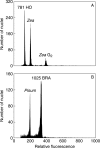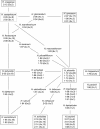Genome size variation and species relationships in Hieracium sub-genus Pilosella (Asteraceae) as inferred by flow cytometry
- PMID: 17921526
- PMCID: PMC2759259
- DOI: 10.1093/aob/mcm218
Genome size variation and species relationships in Hieracium sub-genus Pilosella (Asteraceae) as inferred by flow cytometry
Abstract
Background and aims: Hieracium sub-genus Pilosella (hawkweeds) is a taxonomically complicated group of vascular plants, the structure of which is substantially influenced by frequent interspecific hybridization and polyploidization. Two kinds of species, 'basic' and 'intermediate' (i.e. hybridogenous), are usually recognized. In this study, genome size variation was investigated in a representative set of Central European hawkweeds in order to assess the value of such a data set for species delineation and inference of evolutionary relationships.
Methods: Holoploid and monoploid genome sizes (C- and Cx-values) were determined using propidium iodide flow cytometry for 376 homogeneously cultivated individuals of Hieracium sub-genus Pilosella, including 24 species (271 individuals), five recent natural hybrids (seven individuals) and experimental F(1) hybrids from four parental combinations (98 individuals). Chromosome counts were available for more than half of the plant accessions. Base composition (proportion of AT/GC bases) was cytometrically estimated in 73 individuals.
Key results: Seven different ploidy levels (2x-8x) were detected, with intraspecific ploidy polymorphism (up to four different cytotypes) occurring in 11 wild species. Mean 2C-values varied approx. 4.3-fold from 3.53 pg in diploid H. hoppeanum to 15.30 pg in octoploid H. brachiatum. 1Cx-values ranged from 1.72 pg in H. pilosella to 2.16 pg in H. echioides (1.26-fold). The DNA content of (high) polyploids was usually proportional to the DNA values of their diploid/low polyploid counterparts, indicating lack of processes altering genome size (i.e. genome down-sizing). Most species showed constant nuclear DNA amounts, exceptions being three hybridogenous taxa, in which introgressive hybridization was suggested as a presumable trigger for genome size variation. Monoploid genome sizes of hybridogenous species were always between the corresponding values of their putative parents. In addition, there was a good congruency between actual DNA estimates and theoretical values inferred from putative parental combinations and between DNA values of experimental F(1) hybrids and corresponding established hybridogenous taxa.
Conclusions: Significant differences in genome size between hawkweed species from hybridogenous lineages involving the small-genome H. pilosella document the usefulness of nuclear DNA content as a supportive marker for reliable delineation of several of the most problematic taxa in Hieracium sub-genus Pilosella (including classification of borderline morphotypes). In addition, genome size data were shown to have a good predictive value for inferring evolutionary relationships and genome constitution (i.e. putative parental combinations) in hybridogenous species.
Figures




Similar articles
-
Genome size in Hieracium subgenus Hieracium (Asteraceae) is strongly correlated with major phylogenetic groups.Ann Bot. 2009 Jul;104(1):161-78. doi: 10.1093/aob/mcp107. Epub 2009 May 11. Ann Bot. 2009. PMID: 19433417 Free PMC article.
-
Interspecific hybridization among Hieracium species in New Zealand: evidence from flow cytometry.Heredity (Edinb). 2004 Jul;93(1):34-42. doi: 10.1038/sj.hdy.6800476. Heredity (Edinb). 2004. PMID: 15138450
-
Genome size variation in the genus Carthamus (Asteraceae, Cardueae): systematic implications and additive changes during allopolyploidization.Ann Bot. 2006 Mar;97(3):461-7. doi: 10.1093/aob/mcj050. Epub 2006 Jan 3. Ann Bot. 2006. PMID: 16390843 Free PMC article.
-
The origin, evolution and proposed stabilization of the terms 'genome size' and 'C-value' to describe nuclear DNA contents.Ann Bot. 2005 Jan;95(1):255-60. doi: 10.1093/aob/mci019. Ann Bot. 2005. PMID: 15596473 Free PMC article. Review.
-
Preliminary Review of the Diploid Taxa in Hieracium s.s.Plants (Basel). 2025 Mar 29;14(7):1057. doi: 10.3390/plants14071057. Plants (Basel). 2025. PMID: 40219125 Free PMC article. Review.
Cited by
-
Cytotype distribution at a diploid-hexaploid contact zone in Aster amellus (Asteraceae).Ann Bot. 2012 Oct;110(5):1047-55. doi: 10.1093/aob/mcs177. Epub 2012 Aug 10. Ann Bot. 2012. PMID: 22887024 Free PMC article.
-
Genomic C-Value Variation Analysis in Jujube (Ziziphus jujuba Mill.) in the Middle Yellow River Basin.Plants (Basel). 2023 Feb 14;12(4):858. doi: 10.3390/plants12040858. Plants (Basel). 2023. PMID: 36840207 Free PMC article.
-
Intraspecific variations in cardamom (Elettaria cardamomum Maton): assessment of genomic diversity by flow cytometry, cytological studies and ISSR analysis.Springerplus. 2016 Sep 13;5(1):1560. doi: 10.1186/s40064-016-3226-x. eCollection 2016. Springerplus. 2016. PMID: 27652133 Free PMC article.
-
What is Normalization? The Strategies Employed in Top-Down and Bottom-Up Proteome Analysis Workflows.Proteomes. 2019 Aug 22;7(3):29. doi: 10.3390/proteomes7030029. Proteomes. 2019. PMID: 31443461 Free PMC article. Review.
-
Chromosomes carrying meiotic avoidance loci in three apomictic eudicot Hieracium subgenus Pilosella species share structural features with two monocot apomicts.Plant Physiol. 2011 Nov;157(3):1327-41. doi: 10.1104/pp.111.181164. Epub 2011 Sep 6. Plant Physiol. 2011. PMID: 21896890 Free PMC article.
References
-
- Barow M, Meister A. Lack of correlation between AT frequency and genome size in higher plants and the effect of nonrandomness of base sequences on dye binding. Cytometry. 2002;47:1–7. - PubMed
-
- Bennett MD, Leitch IJ. Plant DNA C-values Database (release 4·0, October 2005) 2005. [Accessed 19 February 2007]. http://www.kew.org/cval/homepage.html .
-
- Bennett MD, Bhandol P, Leitch IJ. Nuclear DNA amounts in angiosperms and their modern uses – 807 new estimates. Annals of Botany. 2000;86:859–909.
-
- Bicknell RA, Lambie SC, Butler RC. Quantification of progeny classes in two facultatively apomictic accessions of Hieracium. Hereditas. 2003;138:11–20. - PubMed
Publication types
MeSH terms
Substances
LinkOut - more resources
Full Text Sources
Miscellaneous

